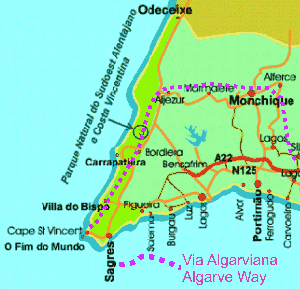Conservation
Articles Out with
Papa Figos Algarve
Books
Wildlife Sites and Walks in the Western Algarve
List of Sites and Walks...

General information
The western and southern coasts of this part of the Algarve are dominated by towering cliffs that have good public access and provide wonderful views. The garrigue habitats around Cape St Vincent in particular are popular with tourists, who can enjoy stunning scenerywithout leaving their cars. The wildlife, wildflowers and fungi that you are likely to see on walks within Cape St Vincent Natural Park are described and illustrated on our page dedicated to that special site...
To the west of Luz the pretty coastal villages are small, with tiny harbours in secluded coves with lovely sheltered beaches. Further east the larger seaside towns of Luz, Lagos, Alvor and Portinao are popular holiday resorts with wider river estuaries and busy harbours and marinas. Walks along the quays and harbours are level with plenty of benches where you can rest and watch the bustle of boats and busy birds begging or stealing food from people eating outside cafes or enjoying picnics on the quayside.
Apart from river fringes, there is little open grassland on the west coast, but on the low hillslopes around Villa do Bispo, Salema and Burgau there are some interesting walks through fallow farmland, sometimes smothered in various poppies, Crown Daisy, Chrysanthemum coronarium, Large Blue Alkanet, Anchusa azurea and a host of other wildflowers. As you would expect, these are favoured haunts of butterflies in springtime, while later in the year the seedheads attract finches and other passerine birds.
Move just a short distance inland and the terrain soon becomes hilly, cut deeply by small streams that run in winter but rapidly drying up (although their margins staying much greener than the surrounding hills) in summer. Tidal reaches of some of the streams are bordered by marshy grassland where you can walk among many beautiful wildflowers includingPaperwhite Narcissus, Narcissus papyraceus, Sea Daffodil, Pancratium maritimum, and Sea Holly Eryngium maritimum. Cistus ladanifer, the Gum Cistus, often interspersed with Arbutus unedo, the Strawberry Tree, dominates most of the lower slopes in this area, while in the higher serra Stone Pines, Cork Oaks and the various (and almost ubiquitous) eucalypts are grown.
For each walk listed below, further information, pictures and a more detailed map are available via the links:
Walks in the West
Parque Natural da Sudoeste Alentejano e Costa Vincentina (Cape St. Vincent)
Guided Walks at Sagres and Cape St. Vincent
Boca do Rio - walks of various lengths through lush river valley leading down to the sea between Salema and Burgau
Meia Viana - near Monchique - tracks through woodlands full of wildflowers, orchids and numerous fungi
Praia Figueira - an easy walk through a small wildlife-rich valley to a secluded cove
Carrapateira - easy walks with boardwalks through a natural sand dune system and along spectacular coastal cliffs
For more wildlife walks see our Out with Papa-figos section...
Sue Parker's latest ebook is a revised and enlarged second edition of the acclaimed Wildflowers in the Algarve - an introductory guide. Full details here...
Buy it for just £3.95 on Amazon...
Sue Parker's 5-star acclaimed field guide to the Wild Orchids of the Algarve is now available as an ebook. Full details here...
Buy it for just £5.95 on Amazon...
Please Help Us: If you have found this information interesting and useful, please consider helping to keep First Nature online by making a small donation towards the web hosting and internet costs.
Any donations over and above the essential running costs will help support the conservation work of Plantlife, the Rivers Trust and charitable botanic gardens - as do author royalties and publisher proceeds from books by Pat and Sue.